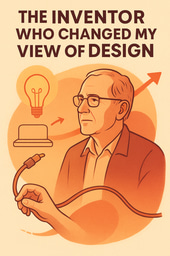Loudspeaker Invention Impact

Journey of Loudspeaker Invention
🔹 1. Pre-Loudspeaker Era (Before 1870s)
-
Sound Amplification was limited to mechanical methods:
-
Megaphones, gramophones, and ear trumpets were common.
-
Acoustic horns were used in early phonographs.
-
🔹 2. Birth of the Loudspeaker Concept
1877 – Thomas Edison & the Phonograph
-
Edison's phonograph used a diaphragm and stylus to reproduce sound mechanically.
-
No electrical amplification – sound was very faint.
1898 – Oliver Lodge
-
Developed early theories of electromagnetic sound reproduction.
🔹 3. First Practical Loudspeakers (Early 20th Century)
1921 – Rice and Kellogg (General Electric)
-
Invented the moving-coil dynamic loudspeaker.
-
This is the core technology still used today.
-
First to use an electromagnetic coil and cone diaphragm to produce amplified sound.
1925 – Patent for Modern Loudspeaker
-
Chester W. Rice & Edward W. Kellogg patented the modern electrodynamic loudspeaker.
🔹 4. Commercial Adoption and Breakthroughs
1926–1930s – Cinema Sound Revolution
-
Theaters adopted electroacoustic sound systems.
-
Altec Lansing and Western Electric became major players in loudspeaker tech for cinema.
1940s – Home Radio and Hi-Fi
-
Loudspeakers became common in radios and home music systems.
-
Introduction of woofer, tweeter, and crossovers for full-range audio reproduction.
How It Changed the Electroacoustic Engineering World
1. Birth of Electroacoustics as a Field
-
Loudspeakers necessitated the study of sound wave behavior, frequency response, and acoustics.
-
Created the domain of electroacoustic engineering, a bridge between electrical and acoustical sciences.
2. Audio System Design
-
Introduced the need for:
-
Amplifiers
-
Equalization and filtering
-
Impedance matching
-
Signal processing
-
3. Architectural Acoustics
-
Loudspeaker integration into auditoriums, stadiums, houses of worship, and public spaces reshaped building design.
-
Engineers now model acoustic reflections, absorption, and coverage using simulation tools.
4. Music and Broadcast Industry
-
Enabled:
-
Live sound reinforcement
-
Studio monitoring
-
Personal listening (headphones/speakers)
-
-
Powered the evolution of genres like Rock, EDM, Jazz, where loudness and clarity were key.
5. Communication and Public Address
-
Revolutionized public safety, transportation hubs, schools, and corporate environments.
-
Gave rise to PA systems, paging, and intercom networks.
6. Multimedia & Immersive Experiences
-
Led to innovations in:
-
Surround sound (5.1, 7.1)
-
VR/AR audio
-
Cinema Dolby Atmos
-
Ambisonics and spatial audio
-
Engineering Advances Sparked by Loudspeaker Tech
| Area | Advances |
|---|---|
| Materials | Polymer cones, Kevlar, carbon fiber diaphragms |
| Transducer Design | Ribbon, planar magnetic, electrostatic speakers |
| Signal Processing | DSP, FIR filters, beamforming |
| Simulation | Finite Element Analysis (FEA), EASE, COMSOL |
| Measurement | Audio analyzers, anechoic chambers, real-time spectrum analyzers |
Final Thought
The invention of the loudspeaker did not just amplify sound — it amplified human potential to communicate, entertain, and inspire.
It bridged the gap between electric signals and human perception, establishing the backbone of modern audio engineering and transforming the way we design spaces, deliver information, and experience sound.
🎉🎉🎉 Three Cheers to Engineering & Innovators! 🎉🎉🎉
-
Xchange Advocates are recognized AV/IT industry thought leaders and influencers. We invite you to connect with them and follow their activity across the community as they offer valuable insights and expertise while advocating for and building awareness of the AV industry.
Recommended Content
AV for Sports Industry in India with Cricket Prospective






Please sign in or register for FREE
If you are a registered user on AVIXA Xchange, please sign in
En español, plase............
La historia de la invención del altavoz es un relato fascinante de innovación, experimentación y transformación que ha influido profundamente en el mundo de la electroacústica, moldeando industrias como el entretenimiento, la comunicación, la arquitectura y la ingeniería.
1. Era Pre-Altavoz (Antes de 1870)La amplificación del sonido estaba limitada a métodos mecánicos:
-
-
2. Nacimiento del Concepto de AltavozSe usaban megáfonos, gramófonos y trompetas acústicas.
Se empleaban bocinas acústicas en los primeros fonógrafos.
📌 1877 – Thomas Edison y el Fonógrafo
El fonógrafo de Edison usaba un diafragma y una aguja para reproducir el sonido mecánicamente.
No había amplificación eléctrica, por lo tanto, el sonido era muy débil.
📌 1898 – Oliver Lodge
3. Primeros Altavoces Prácticos (Principios del Siglo XX)Desarrolló las primeras teorías sobre la reproducción electromagnética del sonido.
📌 1921 – Rice y Kellogg (General Electric)
Inventaron el altavoz dinámico de bobina móvil.
Esta es la tecnología principal que aún se utiliza hoy.
Fueron los primeros en usar una bobina electromagnética y un diafragma cónico para producir sonido amplificado.
📌 1925 – Patente del Altavoz Moderno
4. Adopción Comercial e InnovacionesChester W. Rice y Edward W. Kellogg patentaron el altavoz electrodinámico moderno.
📌 1926–1930s – Revolución del Sonido en el Cine
Los teatros adoptaron sistemas de sonido electroacústico.
Altec Lansing y Western Electric se convirtieron en actores clave en la tecnología de altavoces para cine.
📌 1940s – Radio Doméstica y Alta Fidelidad (Hi-Fi)
Cómo Transformó el Mundo de la Ingeniería Electroacústica 1. Nacimiento de la Electroacústica como CampoLos altavoces se volvieron comunes en radios y sistemas de música para el hogar.
Se introdujeron el woofer, tweeter y los crossovers para una reproducción de audio de rango completo.
Los altavoces exigieron el estudio del comportamiento de las ondas sonoras, la respuesta en frecuencia y la acústica.
2. Diseño de Sistemas de AudioCrearon el campo de la ingeniería electroacústica, un puente entre las ciencias eléctricas y acústicas.
Se hizo necesario el uso de:
-
-
-
-
3. Acústica ArquitectónicaAmplificadores
Ecualización y filtrado
Coincidencia de impedancia
Procesamiento de señales
La integración de altavoces en auditorios, estadios, templos y espacios públicos transformó el diseño arquitectónico.
4. Industria Musical y de RadiodifusiónLos ingenieros ahora modelan reflexiones, absorción y cobertura acústica usando herramientas de simulación.
Permitió:
-
-
-
-
5. Comunicación y Sonido AmbientalRefuerzo de sonido en vivo
Monitoreo de estudio
Escucha personal (auriculares/altavoces)
Impulsó géneros como el rock, EDM y jazz, donde la claridad y la potencia eran esenciales.
Revolucionó la seguridad pública, terminales de transporte, escuelas y entornos corporativos.
6. Multimedia y Experiencias InmersivasDio origen a los sistemas de megafonía (PA), intercomunicadores y redes de avisos.
Lideró innovaciones en:
-
-
-
-
Avances en Ingeniería Impulsados por la Tecnología de Altavoces Área Avances Materiales Conos de polímero, diafragmas de Kevlar y fibra de carbono Diseño de Transductores Altavoces de cinta, magnéticos planos, electrostáticos Procesamiento de Señal DSP, filtros FIR, formación de haces (beamforming) Simulación Análisis de Elementos Finitos (FEA), EASE, COMSOL Medición Analizadores de audio, cámaras anecoicas, analizadores espectrales en tiempo real Reflexión FinalSonido envolvente (5.1, 7.1)
Audio en Realidad Virtual y Aumentada
Cine con Dolby Atmos
Ambisónica y audio espacial
La invención del altavoz no solo amplificó el sonido, amplificó el potencial humano para comunicarse, entretener e inspirar.
Conectó señales eléctricas con la percepción humana, estableciendo la base de la ingeniería de audio moderna y transformando la forma en que diseñamos espacios, compartimos información y experimentamos el sonido.
🎉🎉🎉 ¡Tres hurras por la ingeniería y los innovadores! 🎉🎉🎉
What a fantastic overview of the loudspeaker’s impact on audio engineering and our everyday lives! Truly amazing how this invention shaped so many industries and experiences !
Love this trip down memory lane!